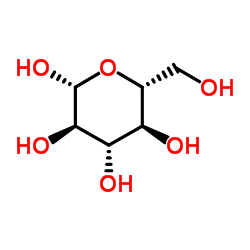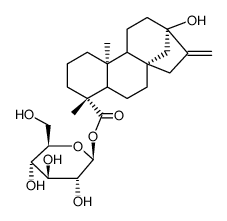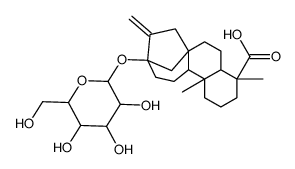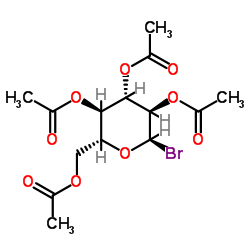Rubusoside
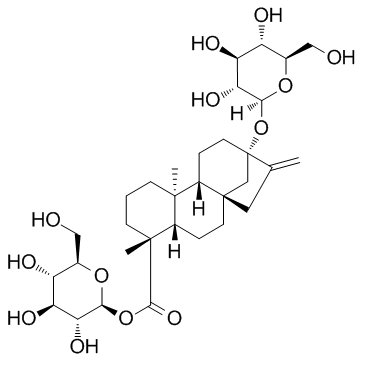
Rubusoside structure
|
Common Name | Rubusoside | ||
|---|---|---|---|---|
| CAS Number | 64849-39-4 | Molecular Weight | 642.732 | |
| Density | 1.5±0.1 g/cm3 | Boiling Point | 802.5±65.0 °C at 760 mmHg | |
| Molecular Formula | C32H50O13 | Melting Point | N/A | |
| MSDS | Chinese USA | Flash Point | 251.9±27.8 °C | |
Use of RubusosideRubusoside is a natural sweetener and a solubilizing agent with antiangiogenic and antiallergic properties. Rubusoside is an excellent solubilizing agent. It can enhance the solubility of a number of pharmaceutically important compounds, such as liquiritin, teniposide, curcumin, and etoposide. |
| Name | rubusoside |
|---|---|
| Synonym | More Synonyms |
| Description | Rubusoside is a natural sweetener and a solubilizing agent with antiangiogenic and antiallergic properties. Rubusoside is an excellent solubilizing agent. It can enhance the solubility of a number of pharmaceutically important compounds, such as liquiritin, teniposide, curcumin, and etoposide. |
|---|---|
| Related Catalog | |
| References |
| Density | 1.5±0.1 g/cm3 |
|---|---|
| Boiling Point | 802.5±65.0 °C at 760 mmHg |
| Molecular Formula | C32H50O13 |
| Molecular Weight | 642.732 |
| Flash Point | 251.9±27.8 °C |
| Exact Mass | 642.325134 |
| PSA | 215.83000 |
| LogP | 1.83 |
| Vapour Pressure | 0.0±6.4 mmHg at 25°C |
| Index of Refraction | 1.628 |
| Storage condition | -20°C |
|
Section1. IDENTIFICATION OF THE SUBSTANCE/MIXTURE Product identifiers Product name: Rubusoside CAS-No.: 64849-39-4 Relevant identified uses of the substance or mixture and uses advised against Identified uses: Laboratory chemicals, Manufacture of substances Section2. HAZARDS IDENTIFICATION Classification of the substance or mixture Not a hazardous substance or mixture according to Regulation (EC) No. 1272/2008. This substance is not classified as dangerous according to Directive 67/548/EEC. Label elements The product does not need to be labelled in accordance with EC directives or respective national laws. Other hazards - none Section3. COMPOSITION/INFORMATION ON INGREDIENTS Substances Formula: C32H50O13 Molecular Weight: 642,73 g/mol Section4. FIRST AID MEASURES Description of first aid measures If inhaled If breathed in, move person into fresh air. If not breathing, give artificial respiration. In case of skin contact Wash off with soap and plenty of water. In case of eye contact Flush eyes with water as a precaution. If swallowed Never give anything by mouth to an unconscious person. Rinse mouth with water. Most important symptoms and effects, both acute and delayed To the best of our knowledge, the chemical, physical, and toxicological properties have not been thoroughly investigated. Indication of any immediate medical attention and special treatment needed no data available Section5. FIREFIGHTING MEASURES Extinguishing media Suitable extinguishing media Use water spray, alcohol-resistant foam, dry chemical or carbon dioxide. Special hazards arising from the substance or mixture Carbon oxides Advice for firefighters Wear self contained breathing apparatus for fire fighting if necessary. Further information no data available Section6. ACCIDENTAL RELEASE MEASURES Personal precautions, protective equipment and emergency procedures Avoid dust formation. Avoid breathing vapors, mist or gas. Environmental precautions Do not let product enter drains. Methods and materials for containment and cleaning up Sweep up and shovel. Keep in suitable, closed containers for disposal. Reference to other sections For disposal see section 13. Section7. HANDLING AND STORAGE Precautions for safe handling Provide appropriate exhaust ventilation at places where dust is formed. Conditions for safe storage, including any incompatibilities Store in cool place. Keep container tightly closed in a dry and well-ventilated place. Specific end uses no data available Section8. EXPOSURE CONTROLS/PERSONAL PROTECTION Control parameters Components with workplace control parameters Exposure controls Appropriate engineering controls General industrial hygiene practice. Personal protective equipment Eye/face protection Use equipment for eye protection tested and approved under appropriate government standards such as NIOSH (US) or EN 166(EU). Skin protection Handle with gloves. Gloves must be inspected prior to use. Use proper glove removal technique (without touching glove's outer surface) to avoid skin contact with this product. Dispose of contaminated gloves after use in accordance with applicable laws and good laboratory practices. Wash and dry hands. The selected protective gloves have to satisfy the specifications of EU Directive 89/686/EEC and the standard EN 374 derived from it. Body Protection Choose body protection in relation to its type, to the concentration and amount of dangerous substances, and to the specific work-place., The type of protective equipment must be selected according to the concentration and amount of the dangerous substance at the specific workplace. Respiratory protection Respiratory protection is not required. Where protection from nuisance levels of dusts are desired, use type N95 (US) or type P1 (EN 143) dust masks. Use respirators and components tested and approved under appropriate government standards such as NIOSH (US) or CEN (EU). Section9. PHYSICAL AND CHEMICAL PROPERTIES Information on basic physical and chemical properties a) AppearanceForm: solid b) Odourno data available c) Odour Thresholdno data available d) pHno data available e) Melting point/freezingno data available point f) Initial boiling point and no data available boiling range g) Flash pointno data available h) Evaporation rateno data available i) Flammability (solid, gas) no data available j) Upper/lowerno data available flammability or explosive limits k) Vapour pressureno data available l) Vapour densityno data available m) Relative densityno data available n) Water solubilityno data available o) Partition coefficient: n- no data available octanol/water p) Autoignitionno data available temperature q) Decompositionno data available temperature r) Viscosityno data available s) Explosive propertiesno data available t) Oxidizing propertiesno data available Other safety information no data available Section10. STABILITY AND REACTIVITY Reactivity no data available Chemical stability no data available Possibility of hazardous reactions no data available Conditions to avoid no data available Incompatible materials Strong oxidizing agents Hazardous decomposition products Other decomposition products - no data available Section11. TOXICOLOGICAL INFORMATION Information on toxicological effects Acute toxicity no data available Skin corrosion/irritation no data available Serious eye damage/eye irritation no data available Respiratory or skin sensitization no data available Germ cell mutagenicity no data available Carcinogenicity IARC:No component of this product present at levels greater than or equal to 0.1% is identified as probable, possible or confirmed human carcinogen by IARC. Reproductive toxicity no data available Specific target organ toxicity - single exposure no data available Specific target organ toxicity - repeated exposure no data available Aspiration hazard no data available Potential health effects InhalationMay be harmful if inhaled. May cause respiratory tract irritation. IngestionMay be harmful if swallowed. SkinMay be harmful if absorbed through skin. May cause skin irritation. EyesMay cause eye irritation. Signs and Symptoms of Exposure To the best of our knowledge, the chemical, physical, and toxicological properties have not been thoroughly investigated. Additional Information RTECS: Not available Section12. ECOLOGICAL INFORMATION Toxicity no data available Persistence and degradability no data available Bioaccumulative potential no data available Mobility in soil no data available Results of PBT and vPvB assessment no data available Other adverse effects no data available Section13. DISPOSAL CONSIDERATIONS Waste treatment methods Product Offer surplus and non-recyclable solutions to a licensed disposal company. Contaminated packaging Dispose of as unused product. Section14. TRANSPORT INFORMATION UN number ADR/RID: -IMDG: -IATA: - UN proper shipping name ADR/RID: Not dangerous goods IMDG: Not dangerous goods IATA:Not dangerous goods Transport hazard class(es) ADR/RID: -IMDG: -IATA: - Packaging group ADR/RID: -IMDG: -IATA: - Environmental hazards ADR/RID: noIMDG Marine pollutant: noIATA: no Special precautions for user no data available Section15. REGULATORY INFORMATION This safety datasheet complies with the requirements of Regulation (EC) No. 1907/2006. Safety, health and environmental regulations/legislation specific for the substance or mixture no data available Chemical Safety Assessment no data available Section16. OTHER INFORMATION Further information Copyright 2012 Co. LLC. License granted to make unlimited paper copies for internal use only. The above information is believed to be correct but does not purport to be all inclusive and shall be used only as a guide. The information in this document is based on the present state of our knowledge and is applicable to the product with regard to appropriate safety precautions. It does not represent any guarantee of the properties of the product. Corporation and its Affiliates shall not be held liable for any damage resulting from handling or from contact with the above product. See and/or the reverse side of invoice or packing slip for additional terms and conditions of sale. |
| RIDADR | NONH for all modes of transport |
|---|---|
| HS Code | 29389090 |
|
~11%
Detail
|
| Literature: Phytochemistry (Elsevier), , vol. 30, # 12 p. 3989 - 3992 |
|
~% 
Rubusoside CAS#:64849-39-4
Detail
|
| Literature: Chemical and Pharmaceutical Bulletin, , vol. 39, # 12 p. 3172 - 3174 |
|
~% 
Rubusoside CAS#:64849-39-4
Detail
|
| Literature: Chemical and Pharmaceutical Bulletin, , vol. 39, # 12 p. 3172 - 3174 |
| Precursor 4 | |
|---|---|
| DownStream 0 | |
|
Cytotoxic and antiangiogenic paclitaxel solubilized and permeation-enhanced by natural product nanoparticles.
Anticancer Drugs 26(2) , 167-79, (2014) Paclitaxel (PTX) is one of the most potent intravenous chemotherapeutic agents to date, yet an oral formulation has been problematic because of its low solubility and permeability. Using the recently ... |
|
|
[Identification and biotransformation properties of a bacterium that converts stevioside into rubusoside].
Wei Sheng Wu Xue Bao 51(1) , 43-9, (2011) The purpose of our study was to separate and identify a bacillus that could convert stevioside specifically. Then we identified the conversion product and studied the conversion capability of the baci... |
|
|
[Study on quality control of Rubus suavissimus].
Zhong Yao Cai 31(11) , 1734-7, (2008) To control the quality of Rubus suavissimus.We inspected the character observation, microscopic, physical and chemical identification, TLC, the examination of water and extraction of Rubus suavissimus... |
| Rubusoside |
| UNII-TCV5K3M3GX |
| 1-O-[(5β,8α,9β,10α,13α)-13-(β-D-Glucopyranosyloxy)-18-oxokaur-16-en-18-yl]-β-D-glucopyranose |
| 1-O-[(5β,8α,9β,10α,13α)-13-(β-D-Glucopyranosyloxy)-19-oxokaur-16-en-19-yl]-β-D-glucopyranose |
| rubescensin a(rg) |
